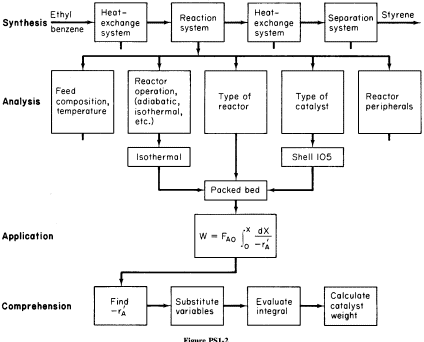

|
|
|
|
Problem solving is an activity whereby a best value is determined for an unknown, which is subject to a set of constraints. To determine how to attack a problem, three problem classifications can be used to direct the investigation: by type of unknown, difficulty, and open-endedness.
The authorís preference in problem classification is that of Bloom, who classifies and identifies six problem-solving skills.

Each successive skill level calls for more advanced intellectual ability.

As an application of the strategy outlined in
Figure PS1-1, we consider a thumbnail sketch of the design of a chemical plant. Specifically, we want to produce 200 million pounds of styrene per year from ethylbenzene. First we synthesize a sequence of processing operations
as shown in the synthesis level (row 1) in
Figure PS1-2.
In synthesis level we develop the type and arrangement of operations and equipment to produce ethylbenzene. Next we evaluate this sequence to learn if additional operations are necessary, such as a heat-exchange system following the separation sys
tem or a feed purification system before the first heat exchanger. Following this cursory evaluation of our sequence, we analyze (row 2) each system (i.e. break it down into a number of subproblems). For example, Figure PS1-2 shows an analysis of t
he reaction system. Here, we determine the type of reactor and catalyst to be used, the best temperature at which to carry out the reaction, the type and arrangement of reactor peripherals (e.g., heating/cooling of the reactor), and the optimum feed condi
tions. After breaking down the reaction system into a number of subsystems, we proceed to the application skill level (row 3) to decide which laws or principles are to be applied to each subsystem. For example, to calculate the catalyst weight, W,
we make use of the design equation (Ch. 6) for a packed-bed reactor,
In using our comprehension (level 2) skills we recall or look up the equation that gives
-![]() as a function of concentration, express concentration as a function of conversion X (Ch. 2), carry out the integration, and finally determine the catalyst weight necessary to achieve a
conversion X.
as a function of concentration, express concentration as a function of conversion X (Ch. 2), carry out the integration, and finally determine the catalyst weight necessary to achieve a
conversion X.
